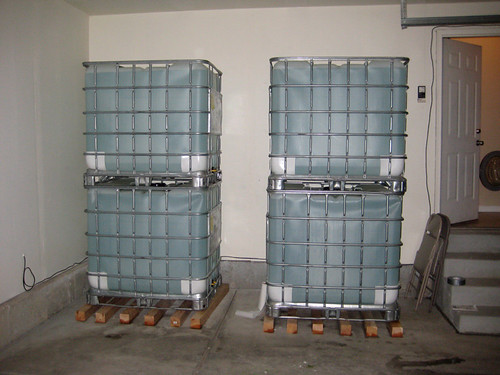Baby Steps:
- Choose Container & Location for storage
- Collect or Purchase containers
- Fill & Date Containers
Why store water?
- Storage of water is one of the simplest but most neglected areas of emergency preparedness. Many people store dried storage foods such as powdered milk, beans, rice, etc. which required water for eating.
- One gallon of water weighs 8 lbs.
- Water is more essential than food in sustaining life.
 How much water do I store?
How much water do I store?According to the Red Cross and Civil defense, you need a minimum of 14 gallons per person for a 2 week period. That is enough for:
1 gallon per person per day, which is bare minimum survival.
3 gallons needed for enough water for personal hygiene, doing dishes.
4 gallons to have enough for more personal care, to wash clothing and minimal cleaning.
If you have pets you need to remember to include about a gallon a day per dog and a pint per day per cat.
Click here to order these water tanks online. Kind of pricey but worth it!
Shelf life of water?
Water must be stored in clean containers and out of sunlight. If stored properly water should have an indefinite shelf life. It is advised that you trade out your water every 6 to 12 months. (Suggested every Oct. Conference or when you change your clocks.) After sitting for a while water will taste flat. You will need to pour it between containers to aerate.
Water must be stored in clean containers and out of sunlight. If stored properly water should have an indefinite shelf life. It is advised that you trade out your water every 6 to 12 months. (Suggested every Oct. Conference or when you change your clocks.) After sitting for a while water will taste flat. You will need to pour it between containers to aerate.
- Gallon of filtered water
- 1 or 2 liter pop bottles
- juice bottles
- mouthwash bottles
- V-8
- punch
- Gatorade
- pedialite bottles
- Any bottles that come with food liquid in them (except oil) can be used.
- DO NOT USE Milk and oil containers!
- barrels designated for water
- coke barrels
- food barrels, as long as the food doesn’t have fat in it
- DO NOT use metal containers!
- 5 gallon plastic water containers are available at army surplus, sporting good stores, discount stores and preparedness stores.
- Dish washing soap bottles, liquid laundry soap bottles & dish washing soap, liquid soap bottles too. After you use it all up, don’t rinse it out. Fill with water and label it soapy water. That way you will have it to use for sanitation and not have to use precious drinking water Cooking, washing dishes, cleaning, personal hygiene, etc.
Where can I store water?
Water is bulky, but in smaller containers you can tuck here and there.
Water is bulky, but in smaller containers you can tuck here and there.
- bathroom cupboards
- in the outer darkness corners of kitchen cupboards
- in the backs of closets
- corners of upper closet shelves
- book shelves
- Behind beds and under beds.
- Food Storage Room
- You can tie a piece of twine or rope around the neck of 2 liter containers, mount a 2×4 along storage walls and hook the liter bottles over nails on those boards. These can be run high next to the ceiling to use otherwise wasted space in storage areas.
Warning: Be sure and keep water out of sunlight, heat and off of concrete floors.
How do I treat water?
It is not necessary to treat water from a public water supply if it is already chlorinated.
Clorox- Amounts according to civil defense guidelines. Double if water is cloudy. After adding proper dosage, stir and allow to stand about 30 minutes.
Quart - 2 drops
½ Gallon - 4 drops
1 Gallon - 16 drops
5 Gallons - 1 tsp
Boiling
It is not necessary to treat water from a public water supply if it is already chlorinated.
Clorox- Amounts according to civil defense guidelines. Double if water is cloudy. After adding proper dosage, stir and allow to stand about 30 minutes.
Quart - 2 drops
½ Gallon - 4 drops
1 Gallon - 16 drops
5 Gallons - 1 tsp
Boiling
Most water can be purified for drinking purposes by boiling it for 5 to 10 minutes.
Purification Tablets
Purification Tablets
Tablets that release iodine may be used safely to purify drinking water.
Essentials of a water treatment kit
Essentials of a water treatment kit
1 bottle Clorox (Clorox will loose it’s “umph” after about 18 months, so this needs to be rotated.)
1 tsp measure
1 medicine dropper
1 funnel
Coffee filters (these would be for filtering water with debris)
1 tsp measure
1 medicine dropper
1 funnel
Coffee filters (these would be for filtering water with debris)

No comments:
Post a Comment